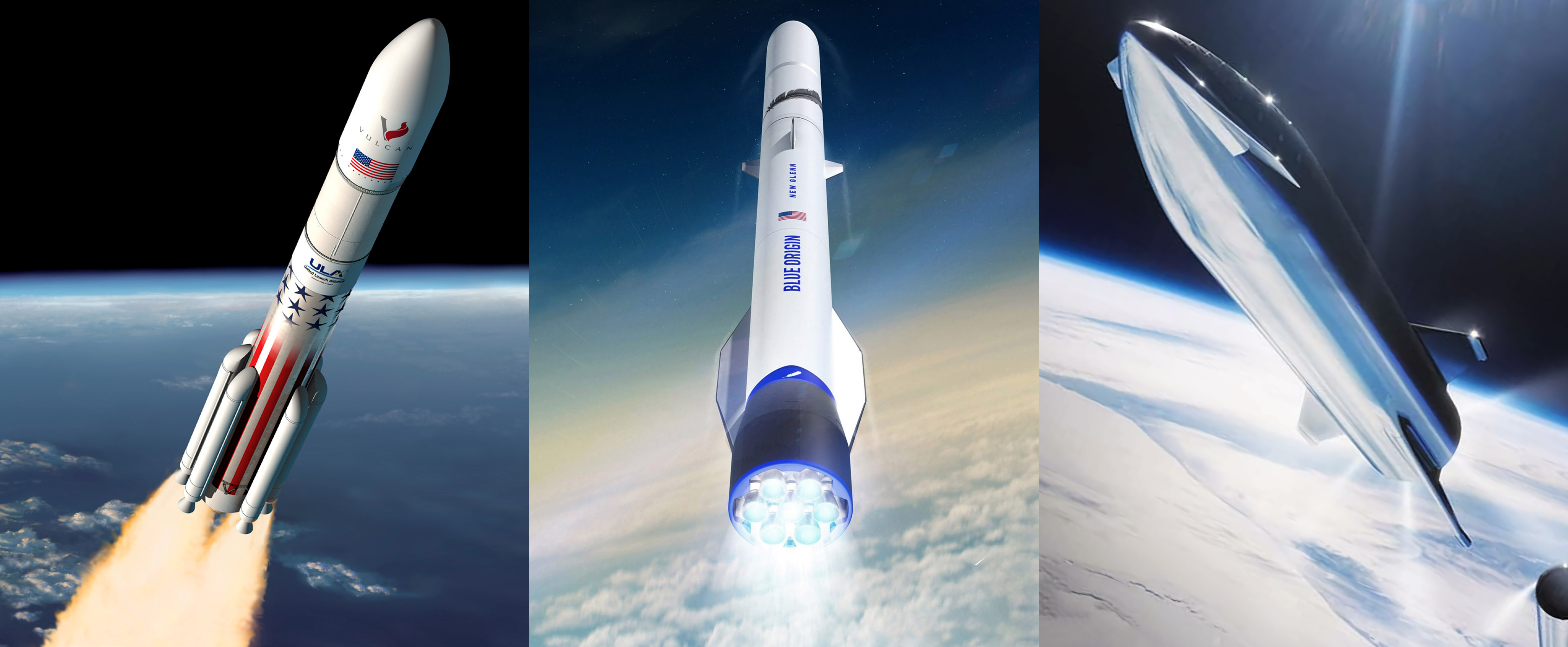

News
SpaceX, Blue Origin, and ULA make major progress in commercial megarocket space race
A new generation of space race is currently underway, but this time it’s not a race to determine which country will reach orbit first, but rather which spaceflight company will successfully reach orbit first with the world’s second generation of super-heavy launch vehicles (SHLVs).
SpaceX, United Launch Alliance (ULA), Blue Origin, and NASA all have plans to build and operate their own SHLV rockets. All entities are deep into design and development and are, for the most part, at various stages of assembly and integration of their first flight hardware, offering an excellent opportunity to compare and contrast the differing approaches at work.
While NASA and ULA are developing rockets featuring an expendable single core supported by solid rocket boosters, SpaceX and Blue Origin have developed reusable designs that will utilize an enormous single core booster powered by multiple engines.
SpaceX: Starship/Super Heavy
Currently the world’s only builder and operator of a super-heavy launch vehicle (Falcon Heavy), SpaceX’s next-generation rocket is undoubtedly the most well known.
The design of SpaceX’s next-generation Starship & Super Heavy rocket is by far the most ambitious. According to company CEO Elon Musk, the new rocket will be comprised of a massive booster deemed “Super Heavy”, featuring as many as 35 Raptor engines capable of producing a total of more than 70,000 kN (15.7M lbf) of thrust at liftoff. The rocket’s upper stage is known as Starship and will be a fully-reusable crew and cargo transport vehicle powered by up to 6 Raptors – 3 sea level-optimized engines and 3 vacuum-optimized engines.
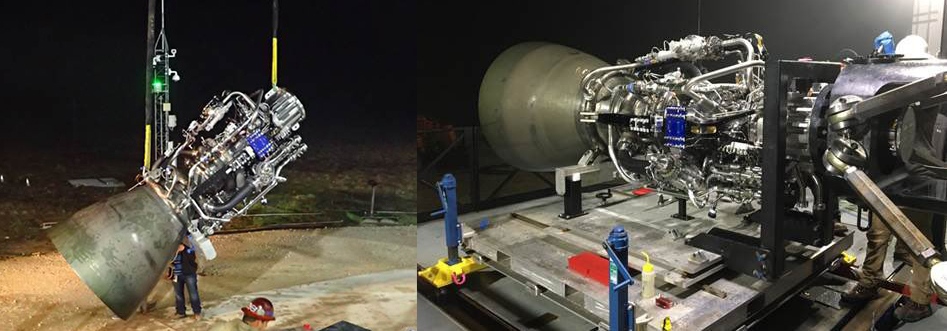
Per a September 2018 design update, Starship and Super Heavy will stand 118 meters (387ft) tall and will be able to launch a minimum of 100 metric tons (220,000 lb) to Low Earth Orbit in a fully reusable configuration, in which both the booster and ship return to Earth for recovery and reuse. On its own, Starship will stand at least 55 meters tall and feature a massive payload bay (or crew section) with a usable volume of no less than 1000 cubic meters (~35,000 ft3). The now-outdated 2018 design also featured almost 90 cubic meters of unpressurized cargo space, a bet less than nine times as much SpaceX’s operational Cargo Dragon spacecraft.
Although CEO Elon Musk has stated that the design of Starship’s legs and control surfaces has since changed, including the addition of legs to Super Heavy boosters, the upper stage’s 2018 design featured two actuating canards and fins/legs, two of which actuate a bit like flapping wings.
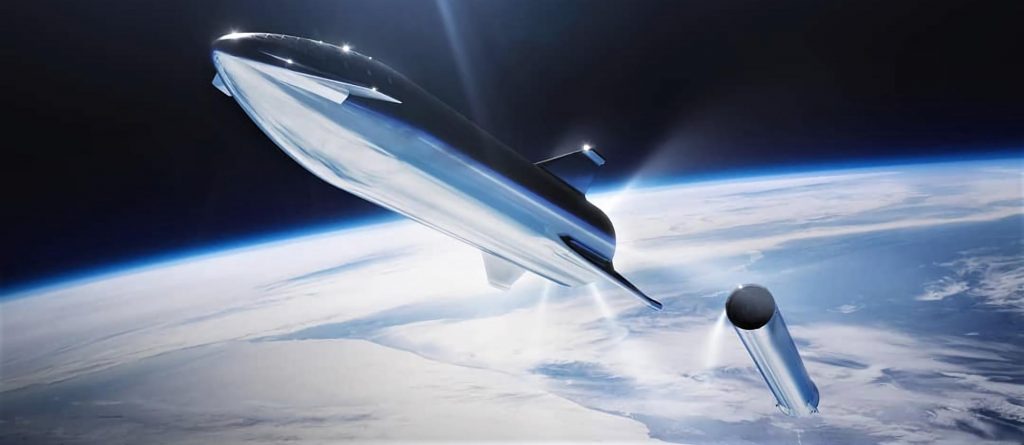
Currently, SpaceX is actively building two orbital Starship prototypes at two separate facilities in Cocoa Beach, Florida and Boca Chica, Texas, as well as an unusual low-fidelity prototype known as Starhopper. Outfitted with a lone Raptor engine (SN06), Starhopper very recently completed a successful 20-meter hop, also the vehicle’s first untethered test flight.
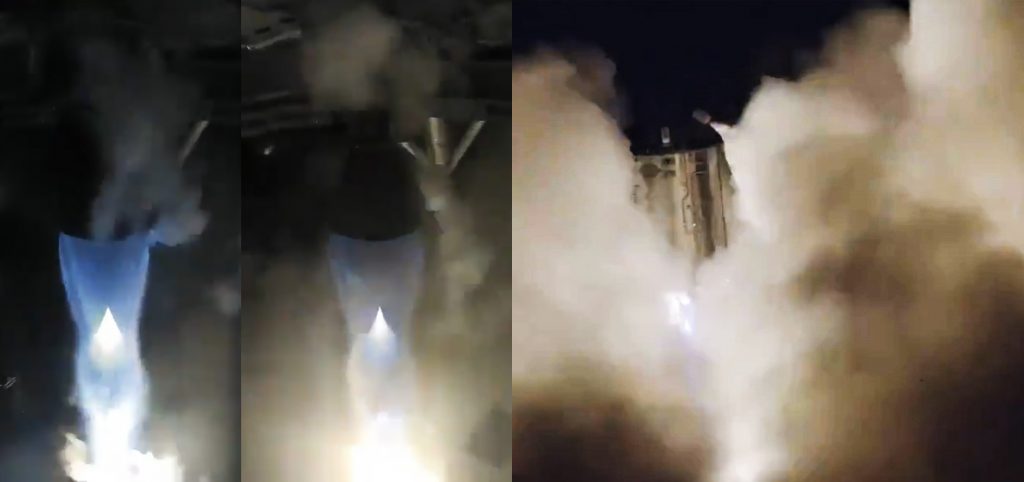
According to Musk, Starhopper is being prepared for a second untethered flight as early as August 16th, in which the rocket will reach a maximum altitude of up to 200 meters (650 ft) and perform a small divert, landing on an adjacent landing pad. Musk also has plans to present a major update on the status of Starship during an official event, scheduled to occur on August 24th in Boca Chica, TX. Aside from hundreds of disconnected snippets in the form of Musk’s prolific tweets, this will mark the first official presentation on Starship since SpaceX made the radical leap from carbon fiber to stainless steel.
SpaceX has taken a truly unprecedented approach to Starship and Super Heavy production and is currently assembling two full-scale Starship prototypes (Mk1 and Mk2) outside with little to no cover, although some spartan covered production facilities are simultaneously being built.
Blue Origin: BE-4 for all
On the near-opposite side of the spectrum, Blue Origin and ULA have formed a partnership in the sense that both companies will ultimately use the same Blue Origin-built engines to power the boosters of their own next-generation launch vehicles. ULA has decided to acquire Blue-built BE-4 engines for its Vulcan Heavy rocket, motivated primarily by the fact that the company will no longer be able to legally import the Russian-built RD-180 used on Atlas V after 2022 as a result of US sanctions.
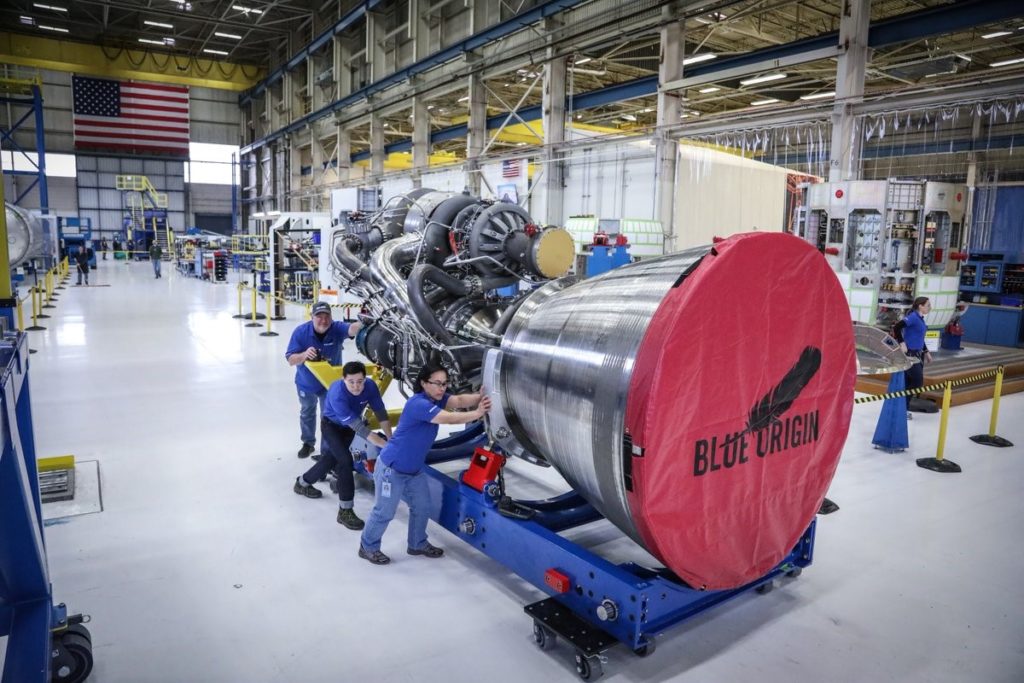
First and foremost, though, Blue Origin is developing BE-4 as the primary propulsion of the company’s own two-stage super heavy-lift rocket, known as New Glenn. New Glenn’s first stage will be powered by 7 of the extremely powerful oxygens, utilizing liquefied natural gas (LNG) and liquid oxygen to produce at least 2,450 kN (550,000 lbf) of thrust. Altogether, New Glenn will lift off with a maximum thrust of 17,100 kN (3.85m lbf) of thrust at sea level.
Unintuitively, New Glenn will actually produce a full 33% less thrust than SpaceX’s Falcon Heavy (~23,000 kN or 5.1M lbf) at liftoff but will likely be able to crush Falcon Heavy’s performance to higher orbits while still in a reusable configuration. This is thanks in large part to the greater efficiency of a single-core rocket, as well as the greater efficiency of its methane-powered BE-4 boost-stage engines and hydrogen-powered BE-3U upper stage engines. According to Blue, New Glenn will be able to launch 45,000 kg to LEO and 13,000 kg to GTO while still recovering the booster, compared to Falcon Heavy’s 8,000-10,000 kg GTO performance.
New Glenn will stand 95 meters (313 ft) tall and feature the largest payload fairing in operation, measuring 7m (23 ft) wide and in diameter. New Glenn’s booster will follow in the footsteps of Blue Origin’s relatively tiny New Shepard and will rely on actuating fins for in-atmosphere maneuvering, as well as two fixed wing-like strakes that will partially function as wings during recovery. New Glenn will also feature six retractable landing legs and land on a modified ship, much like SpaceX’s Falcon family.
While Blue Origin has scarcely published a word or photo on New Glenn’s production progress since its September 2016 reveal, the company does provide small updates on the status of its BE-4 engine every few months, including a photo of a recent full-power engine test completed on August 2nd at Blue’s Van Horn, Texas facilities.
ULA: Vulcan Heavy
ULA’s next-generation Vulcan Heavy rocket will feature two such BE-4 engines but will be fully expendable for at least 4-6 years after its nominal 2021 launch debut. ULA will continue to lean on their well-worn preference for supplementing liquid propulsion with 2-6 strap-on solid rocket boosters (SRBs), adding as much as ~12,000 kN (2.7M lbf) to booster’s two BE-4s, themselves producing 4,800 kN (1.1M lbf) of thrust
In its largest configuration, Vulcan Heavy will stand 69.2 m (227 ft) tall – just a tad shorter than Falcon 9 – and be capable of launch up to 15 tons (~33,000 lb) to GTO and 30.3 tons (67,000 lb) to LEO.
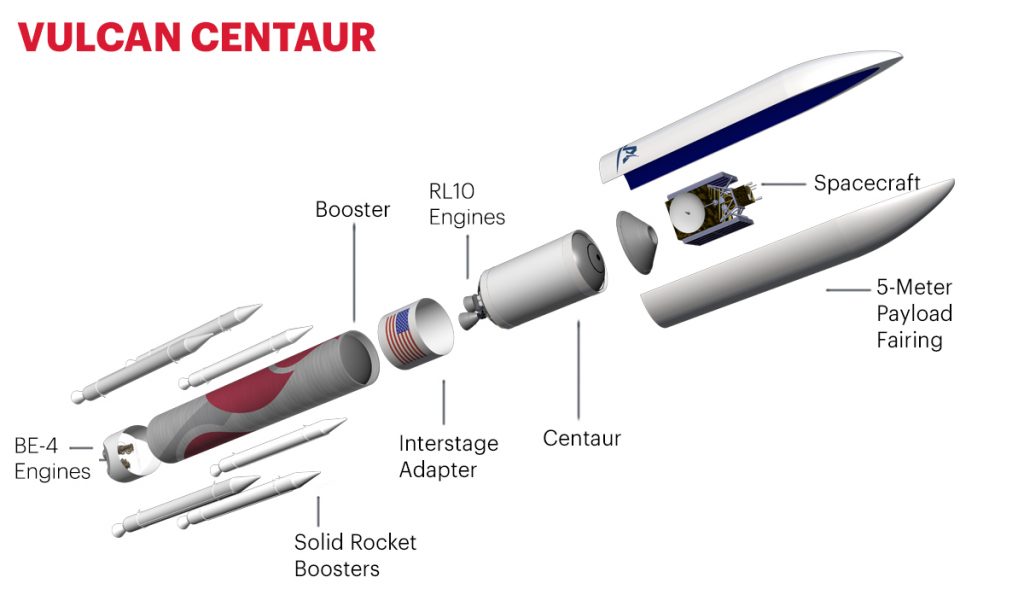
ULA CEO Tory Bruno recently took to Twitter to provide a small Vulcan development update, revealing that the first Vulcan booster was recently completed at the company’s Decatur, Alabama factory. This particularly booster is a structural test article (STA) and will never fly, but it’s still a huge milestone for ULA’s next-generation rocket.
The photos give a great idea of scale as the Vulcan booster is pictured alongside one of the company’s significantly smaller Atlas V booster, 3.8m compared to Vulcan’s 5.4m diameter.
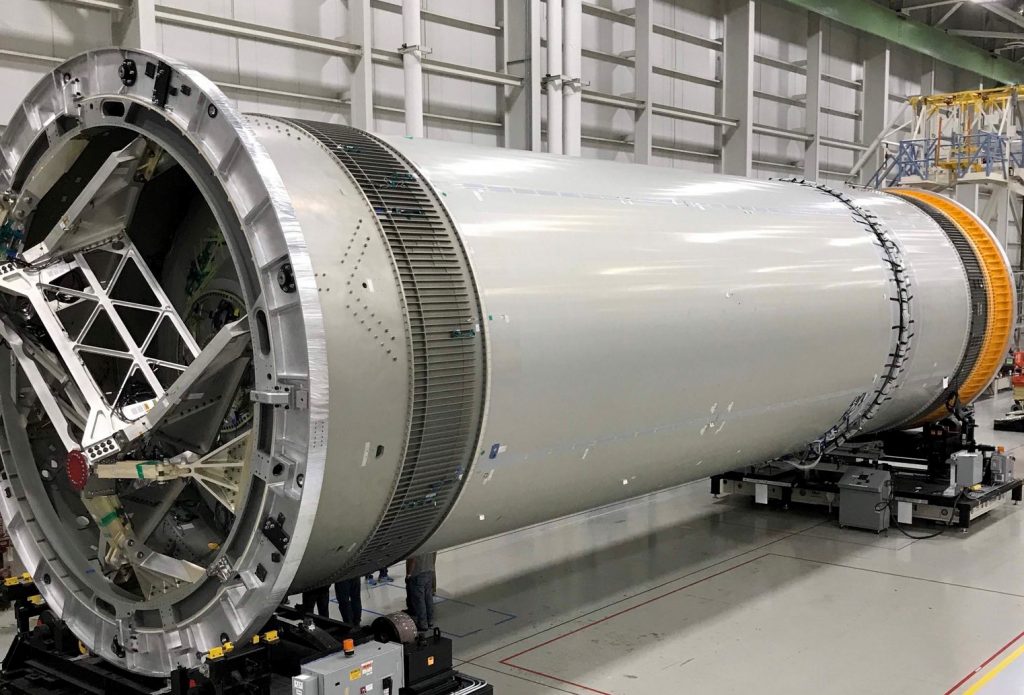
Ultimately, this modern space race will hopefully benefit the spaceflight industry as a whole, particularly with respect to the introduction of New Glenn, hopefully giving SpaceX’s reusable Falcon 9 and Heavy rockets some real technological competition. ULA’s Vulcan is aiming for a H1 2021 debut, followed by New Glenn in late-2021 or 2022.
SpaceX’s Falcon Heavy is already operational and just completed its third launch in June 2019, with several more launch contracts on the books from late-2020 onwards. Its Starship/Super Heavy rocket is in a bit of a chaotic state at the moment, but CEO Elon Musk believes an orbital launch attempt could come as early as early-2020. Meanwhile, NASA is very slowly making its way to the launch debut of its Space Launch System (SLS) rocket, likely to slip into 2022.
With any luck, the early 2020s will be greeted by the operational debuts of two, three, four, or even more extremely capable rockets offering largely unprecedented launch costs. For now, we wait…
Check out Teslarati’s Marketplace! We offer Tesla accessories, including for the Tesla Cybertruck and Tesla Model 3.
News
Tesla begins Robotaxi certification push in Arizona: report
Tesla seems serious about expanding its Robotaxi service to several states in the coming months.

Tesla has initiated discussions with Arizona transportation regulators to certify its driverless Robotaxi service in the state, as per a recent report from Bloomberg News. The move follows Tesla’s launch of its Robotaxi pilot program in Austin, Texas, as well as CEO Elon Musk’s recent comments about the service’s expansion in the Bay Area.
The Arizona Department of Transportation confirmed to Bloomberg that Tesla has reached out to begin the certification process for autonomous ride-sharing operations in the state. While details remain limited, the outreach suggests that Tesla is serious about expanding its driverless Robotaxi service to several territories in the coming months.
The Arizona development comes as Tesla prepares to expand its service area in Austin this weekend, as per CEO Elon Musk in a post on X. Musk also stated that Tesla is targeting the San Francisco Bay Area as its next major market, with a potential launch “in a month or two,” pending regulatory approvals.
Tesla first launched its autonomous ride-hailing program on June 22 in Austin with a small fleet of Model Y vehicles, accompanied by a Tesla employee in the passenger seat to monitor safety. While still classified as a test, Musk has said the program will expand to about 1,000 vehicles in the coming months. Tesla will later upgrade its Robotaxi fleet with the Cyercab, a two-seater that is designed without a steering wheel.
Sightings of Cybercab castings around the Giga Texas complex suggests that Tesla may be ramping the initial trial production of the self-driving two-seater. Tesla, for its part, has noted in the past that volume production of the Cybercab is expected to start sometime next year.
In California, Tesla has already applied for a transportation charter-party carrier permit from the state’s Public Utilities Commission. The company is reportedly taking a phased approach to operating in California, with the Robotaxi service starting with pre-arranged rides for employees in vehicles with safety drivers.
News
Tesla sets November 6 date for 2025 Annual Shareholder Meeting
The automaker announced the date on Thursday in a Form 8-K.

Tesla has scheduled its 2025 annual shareholder meeting for November 6, addressing investor concerns that the company was nearing a legal deadline to hold the event.
The automaker announced the date on Thursday in a Form 8-K submitted to the United States Securities and Exchange Commission (SEC). The company also listed a new proposal submission deadline of July 31 for items to be included in the proxy statement.
Tesla’s announcement followed calls from a group of 27 shareholders, including the leaders of large public pension funds, which urged Tesla’s board to formally set the meeting date, as noted in a report from The Wall Street Journal.
The group noted that under Texas law, where Tesla is now incorporated, companies must hold annual meetings within 13 months of the last one if requested by shareholders. Tesla’s previous annual shareholder meeting was held on June 13, 2024, which placed the July 13 deadline in focus.
Tesla originally stated in its 2024 annual report that it would file its proxy statement by the end of April. However, an amended filing on April 30 indicated that the Board of Directors had not yet finalized a meeting date, at least at the time.
The April filing also confirmed that Tesla’s board had formed a special committee to evaluate certain matters related to CEO Elon Musk’s compensation plan. Musk’s CEO performance award remains at the center of a lengthy legal dispute in Delaware, Tesla’s former state of incorporation.
Due to the aftermath of Musk’s legal dispute about his compensation plan in Delaware, he has not been paid for his work at Tesla for several years. Musk, for his part, has noted that he is more concerned about his voting stake in Tesla than his actual salary.
At last year’s annual meeting, TSLA shareholders voted to reapprove Elon Musk’s compensation plan and ratified Tesla’s decision to relocate its legal domicile from Delaware to Texas.
Elon Musk
Grok coming to Tesla vehicles next week “at the latest:” Elon Musk
Grok’s rollout to Tesla vehicles is expected to begin next week at the latest.

Elon Musk announced on Thursday that Grok, the large language model developed by his startup xAI, will soon be available in Tesla vehicles. Grok’s rollout to Tesla vehicles is expected to begin next week at the latest, further deepening the ties between the two Elon Musk-led companies.
Tesla–xAI synergy
Musk confirmed the news on X shortly after livestreaming the release of Grok 4, xAI’s latest large language model. “Grok is coming to Tesla vehicles very soon. Next week at the latest,” Musk wrote in a post on social media platform X.
During the livestream, Musk and several members of the xAI team highlighted several upgrades to Grok 4’s voice capabilities and performance metrics, positioning the LLM as competitive with top-tier models from OpenAI and Google.
The in-vehicle integration of Grok marks a new chapter in Tesla’s AI development. While Tesla has long relied on in-house systems for autonomous driving and energy optimization, Grok’s integration would introduce conversational AI directly into its vehicles’ user experience. This integration could potentially improve customer interaction inside Tesla vehicles.
xAI and Tesla’s collaborative footprint
Grok’s upcoming rollout to Tesla vehicles adds to a growing business relationship between Tesla and xAI. Earlier this year, Tesla disclosed that it generated $198.3 million in revenue from commercial, consulting, and support agreements with xAI, as noted in a report from Bloomberg News. A large portion of that amount, however, came from the sale of Megapack energy storage systems to the artificial intelligence startup.
In July 2023, Musk polled X users about whether Tesla should invest $5 billion in xAI. While no formal investment has been made so far, 68% of poll participants voted yes, and Musk has since stated that the idea would be discussed with Tesla’s board.
-

 Elon Musk1 week ago
Elon Musk1 week agoTesla investors will be shocked by Jim Cramer’s latest assessment
-

 Elon Musk20 hours ago
Elon Musk20 hours agoxAI launches Grok 4 with new $300/month SuperGrok Heavy subscription
-

 Elon Musk3 days ago
Elon Musk3 days agoElon Musk confirms Grok 4 launch on July 9 with livestream event
-

 News7 days ago
News7 days agoTesla Model 3 ranks as the safest new car in Europe for 2025, per Euro NCAP tests
-

 Elon Musk2 weeks ago
Elon Musk2 weeks agoA Tesla just delivered itself to a customer autonomously, Elon Musk confirms
-

 Elon Musk1 week ago
Elon Musk1 week agoxAI’s Memphis data center receives air permit despite community criticism
-

 Elon Musk2 weeks ago
Elon Musk2 weeks agoTesla’s Omead Afshar, known as Elon Musk’s right-hand man, leaves company: reports
-

 News2 weeks ago
News2 weeks agoXiaomi CEO congratulates Tesla on first FSD delivery: “We have to continue learning!”

















